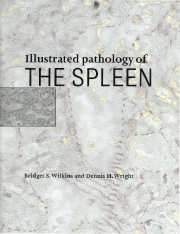Book contents
- Frontmatter
- Contents
- Preface
- Acknowledgements
- 1 Introduction
- 2 Normal structure, development and functions of the spleen
- 3 Post-traumatic and incidentally removed spleens
- 4 The spleen in hereditary blood cell abnormalities and auto-immune disorders
- 5 The spleen in immunodeficiency and systemic infections
- 6 Lymphomas involving the spleen
- 7 The spleen in myeloproliferative disorders
- 8 Pathology of the splenic stroma
- 9 Metastases and miscellaneous conditions
- 10 Summary: some key points in splenic differential diagnosis
- Index
3 - Post-traumatic and incidentally removed spleens
Published online by Cambridge University Press: 14 August 2009
- Frontmatter
- Contents
- Preface
- Acknowledgements
- 1 Introduction
- 2 Normal structure, development and functions of the spleen
- 3 Post-traumatic and incidentally removed spleens
- 4 The spleen in hereditary blood cell abnormalities and auto-immune disorders
- 5 The spleen in immunodeficiency and systemic infections
- 6 Lymphomas involving the spleen
- 7 The spleen in myeloproliferative disorders
- 8 Pathology of the splenic stroma
- 9 Metastases and miscellaneous conditions
- 10 Summary: some key points in splenic differential diagnosis
- Index
Summary
Introduction
Inclusion of these topics in a chapter of their own represents a departure from the traditional pattern of description in diagnostic pathology. However, a high proportion of splenectomies fall into these categories and are often dismissed, erroneously, as normal. We feel that to offer a specific approach to these types of splenectomy is important. Features can be discerned, at least in well-fixed tissue, which will enable the reader to make a confident distinction between insignificant changes, changes secondary to surgery or trauma and those which reflect significant underlying pathology.
Spleens removed incidentally and those removed following trauma are different
In the category of traumatized spleens are included those removed following blunt abdominal injury (caused by a fall, road traffic accident or other crush injury) and open trauma (e.g. due to a gunshot or stab wound). Spleens removed for these reasons require a slightly different approach from those removed purely for technical reasons during abdominal surgery. The latter specimens are usually removed because of requirement to gain access to a difficult surgical site, inability to preserve splenic blood supply or because capsular damage has been caused accidentally or unavoidably during the surgical procedure. Depending on the nature of the injury which the patient has suffered, pathological changes are more likely to be present in the first group of spleens than in the second, incidental, group.
- Type
- Chapter
- Information
- Illustrated Pathology of the Spleen , pp. 35 - 46Publisher: Cambridge University PressPrint publication year: 2000
- 1
- Cited by



